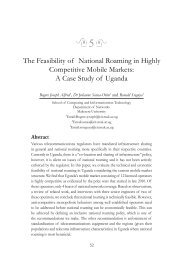Undergraduate Handbook - School of Computing and Informatics ...
Undergraduate Handbook - School of Computing and Informatics ...
Undergraduate Handbook - School of Computing and Informatics ...
Create successful ePaper yourself
Turn your PDF publications into a flip-book with our unique Google optimized e-Paper software.
10.9 Cisco Academy Programmes<br />
In July 2002, Makerere University Faculty <strong>of</strong> <strong>Computing</strong> <strong>and</strong> <strong>Informatics</strong> Technology (CIT) was approved as a<br />
Regional Cisco Networking Academy under a partnership with Cisco Systems Inc. The four popular Cisco<br />
Systems Programmes <strong>of</strong>fered are; (a) Cisco Certified Network Associate (CCNA) (b) Cisco Certified Network<br />
Pr<strong>of</strong>essional (CCNP) (c) Wireless Local Area Network (WLAN) <strong>and</strong> (d) Instructional Technology Essentials I<br />
<strong>and</strong> II (IT Essentials I & II.<br />
A Cisco Certified Network Associate (CCNA) Programme<br />
CCNA is a comprehensive curriculum that includes four separate modules. The curriculum emphasizes the use<br />
<strong>of</strong> decision-making <strong>and</strong> problem-solving techniques to resolve networking issues. Students learn how to<br />
install <strong>and</strong> configure switches <strong>and</strong> routers in local <strong>and</strong> wide-area networks using various protocols <strong>and</strong> provide<br />
Level 1 troubleshooting service, <strong>and</strong> improve network performance <strong>and</strong> security. Additionally, training is provided in<br />
the proper care, maintenance, <strong>and</strong> use <strong>of</strong> networking s<strong>of</strong>tware tools <strong>and</strong> equipment. The CCNA certification course<br />
features the following modules:<br />
a) CCNA Discovery1: Networking for Home <strong>and</strong> Small Businesses<br />
During the Cisco® Networking Academy course, administered by the undersigned instructor, the student<br />
was able to pr<strong>of</strong>iciently: Set up a personal computer system, including the operating system, interface cards<br />
<strong>and</strong> peripheral devices; Plan <strong>and</strong> install a small business network <strong>and</strong> connect it to the Internet; Verify <strong>and</strong><br />
troubleshoot network <strong>and</strong> Internet connectivity; Share resources such as files <strong>and</strong> printers among multiple<br />
computers; Recognize <strong>and</strong> mitigate security threats to a home network; Configure <strong>and</strong> certify common<br />
Internet applications; Configure basic IP services through a GUI.<br />
b) CCNA Discovery2: Working at a Small-to-Medium Business or ISP<br />
During the Cisco® Networking Academy course, administered by the undersigned instructor, the student<br />
was able to pr<strong>of</strong>iciently: Describe the structure <strong>of</strong> the Internet <strong>and</strong> how communication occurs between<br />
hosts; Install, configure, <strong>and</strong> troubleshoot Cisco IOS devices for Internet <strong>and</strong> server connectivity; Plan a<br />
basic wired infrastructure to support network traffic; Configure a server to share resources <strong>and</strong> provide<br />
common Web services; Implement basic WAN connectivity using Telco services; Demonstrate proper<br />
disaster recovery procedures <strong>and</strong> perform server backups; Monitor network performance <strong>and</strong> isolate<br />
failures; Troubleshoot problems using an organized, layered procedure; Describe the OSI model <strong>and</strong> the<br />
process <strong>of</strong> encapsulation.<br />
c) CCNA Discovery3: Introducing Routing <strong>and</strong> Switching in the Enterprise<br />
During the Introducing Routing <strong>and</strong> Switching in the Enterprise course, administered by the undersigned<br />
instructor, the student demonstrated the following competencies: Configure a switch with VLANs <strong>and</strong><br />
inter-switch communication; Perform LAN, WAN, <strong>and</strong> VLAN troubleshooting using a structured<br />
methodology <strong>and</strong> the OSI model; Implement a LAN for an approved network design; Implement access<br />
lists to permit or deny specified traffic; Implement WAN links; Configure routing protocols on Cisco<br />
devices.<br />
d) CCNA Discovery4: Designing <strong>and</strong> Supporting Computer Networks<br />
During the Cisco® Networking Academy course, administered by the undersigned instructor, the student<br />
was able to pr<strong>of</strong>iciently: Gather customer requirements; Design a simple Internetwork using Cisco<br />
technology; Design an IP addressing scheme to meet LAN requirements; Create an equipment list to meet<br />
LAN design requirements; Create <strong>and</strong> present a proposal to a customer; Install <strong>and</strong> configure a prototype<br />
Internetwork; Obtain <strong>and</strong> upgrade Cisco IOS S<strong>of</strong>tware in Cisco devices.<br />
132

















